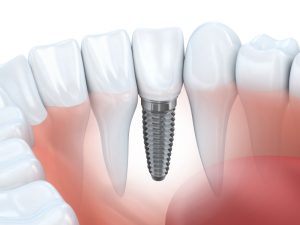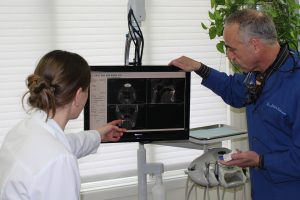 No matter how it happens, tooth loss is a problem. Even a single missing tooth can cause real trouble in an otherwise healthy smile — so finding a sturdy replacement should be a top priority. But in the contest between traditional crowns and bridges or dental implants in the capital district, which is best for you? Both restore your ability to eat, speak, and smile with confidence, but only one stabilizes your jawbone for continued oral health.
No matter how it happens, tooth loss is a problem. Even a single missing tooth can cause real trouble in an otherwise healthy smile — so finding a sturdy replacement should be a top priority. But in the contest between traditional crowns and bridges or dental implants in the capital district, which is best for you? Both restore your ability to eat, speak, and smile with confidence, but only one stabilizes your jawbone for continued oral health.
Capital Smiles Blog
Traditional Crowns and Bridges vs. Dental Implants in Capital District
October 31, 2016
Porcelain Veneers vs. Invisalign: What You Need to Know
September 30, 2016
 Are you interested in correcting your imperfect teeth, but having a hard time choosing between several cosmetic options? It’s easier to decide when you have all the information — and we’re here to help. In the choice between porcelain veneers vs. Invisalign, the one that’s right for you depends on a few factors. Let’s take a closer look at the differences between these two popular cosmetic treatments.
Are you interested in correcting your imperfect teeth, but having a hard time choosing between several cosmetic options? It’s easier to decide when you have all the information — and we’re here to help. In the choice between porcelain veneers vs. Invisalign, the one that’s right for you depends on a few factors. Let’s take a closer look at the differences between these two popular cosmetic treatments.
A Capital District Dentist that Understands Celiac Disease
August 4, 2016
 Celiac disease is an autoimmune condition that affects the way the body reacts to gluten found in wheat, rye, and barley. A person dealing with celiac disease cannot digest these proteins, which wreak havoc on the small intestine. But what about gluten’s effect on the rest of your body? We are constantly learning more about the impact of celiac disease on the teeth. If you suffer from gluten intolerance, make sure you choose a celiac disease dentist who is equipped to provide safe, effective dental care for your condition. The team at Capital Smiles takes a special approach in our care for celiac patients.
Celiac disease is an autoimmune condition that affects the way the body reacts to gluten found in wheat, rye, and barley. A person dealing with celiac disease cannot digest these proteins, which wreak havoc on the small intestine. But what about gluten’s effect on the rest of your body? We are constantly learning more about the impact of celiac disease on the teeth. If you suffer from gluten intolerance, make sure you choose a celiac disease dentist who is equipped to provide safe, effective dental care for your condition. The team at Capital Smiles takes a special approach in our care for celiac patients.
Capital District Dentist Offering IV Sedation, 3D Imaging
July 29, 2016
 At Capital Smiles, we are committed to your comfort and health. That’s why we’re happy to announce we are now the capital district dentist offering IV sedation and 3D imaging! Adding these important features to our list of services increases your comfort and improves results. Keep reading to learn more about each one, and how we can use them to improve your overall dental health.
At Capital Smiles, we are committed to your comfort and health. That’s why we’re happy to announce we are now the capital district dentist offering IV sedation and 3D imaging! Adding these important features to our list of services increases your comfort and improves results. Keep reading to learn more about each one, and how we can use them to improve your overall dental health.
Tooth Extractions in the Capital District
June 10, 2016
 There may come a time when Dr. Erin Page recommend you have a tooth extracted. While tooth extractions are viewed as a last resort, it may be necessary. An extraction is needed when a tooth has become broken or damaged past the point of repair, has significant bone loss, infection or even a crack. In some cases, extraction may be preventative, such as wisdom tooth removal or necessary to create space in conjunction with orthodontic treatment to facilitate tooth alignment. Depending on the reason for the extraction, our Capital District dentists may recommend you have the tooth replaced with a prosthetic. Common tooth replacement options include dental bridges, dentures, or dental implants. As a comprehensive general dental practice that also offers the Capital District dental implants, we provide the extractions and prosthetics you need for a healthy, complete smile.
There may come a time when Dr. Erin Page recommend you have a tooth extracted. While tooth extractions are viewed as a last resort, it may be necessary. An extraction is needed when a tooth has become broken or damaged past the point of repair, has significant bone loss, infection or even a crack. In some cases, extraction may be preventative, such as wisdom tooth removal or necessary to create space in conjunction with orthodontic treatment to facilitate tooth alignment. Depending on the reason for the extraction, our Capital District dentists may recommend you have the tooth replaced with a prosthetic. Common tooth replacement options include dental bridges, dentures, or dental implants. As a comprehensive general dental practice that also offers the Capital District dental implants, we provide the extractions and prosthetics you need for a healthy, complete smile.
Fit Dental Treatment in Your Monthly Budget
May 17, 2016
 For Dr. Page and the entire team at Capital Smiles, your oral health and smile is our priority. We understand, however, that the cost of dental care for you and your family is also an important factor in making decisions regarding your treatment. With this in mind, we offer flexible payment options to help you fit your dental care into your budget.
For Dr. Page and the entire team at Capital Smiles, your oral health and smile is our priority. We understand, however, that the cost of dental care for you and your family is also an important factor in making decisions regarding your treatment. With this in mind, we offer flexible payment options to help you fit your dental care into your budget.
Choosing a Dentist in the Capital District for your Dental Implant Procedure
April 27, 2016
 Dental implants are an excellent means to permanently replace missing teeth using prosthetics that closely mimic your own natural teeth in terms of function and appearance. The process of receiving dental implants is fairly invasive, which is why it is important to take the time to find a qualified and experienced dentist in the Capital District to handle the procedure. Capital Smiles offers dental implants in our Schenectady dental office, through the experience and qualifications of Dr. Erin Page. And, our office offers a number of added benefits to ensure the most successful and comfortable experience possible.
Dental implants are an excellent means to permanently replace missing teeth using prosthetics that closely mimic your own natural teeth in terms of function and appearance. The process of receiving dental implants is fairly invasive, which is why it is important to take the time to find a qualified and experienced dentist in the Capital District to handle the procedure. Capital Smiles offers dental implants in our Schenectady dental office, through the experience and qualifications of Dr. Erin Page. And, our office offers a number of added benefits to ensure the most successful and comfortable experience possible.
(more…)
Achieve Durable Crowns in Schenectady, NY
March 30, 2016
 When serious decay or damage affect your tooth, you may need more than a filling to restore it to its good health. In this case, Dr. Page will do whatever possible to conserve your natural tooth — and conservative dentistry can be accomplished with durable crowns in Schenectady, NY. Keep reading to learn more about this trusted option from Capital Smiles!
When serious decay or damage affect your tooth, you may need more than a filling to restore it to its good health. In this case, Dr. Page will do whatever possible to conserve your natural tooth — and conservative dentistry can be accomplished with durable crowns in Schenectady, NY. Keep reading to learn more about this trusted option from Capital Smiles!
Capital District All-on-4 and All-on-6 Dental Implants
February 1, 2016
 At Capital Smiles, Dr. Page and our team are dedicated to offering our patients the most advanced dental techniques and technologies in order to provide care that is comfortable, convenient, and effective. All-on-4 and All-on-6 dental implant restorations are two treatment solutions that allow us to restore complete smiles that look, feel, and function more like natural teeth. Schedule a dental implant consultation with our Capital District team today to find out which solution is right for you.
At Capital Smiles, Dr. Page and our team are dedicated to offering our patients the most advanced dental techniques and technologies in order to provide care that is comfortable, convenient, and effective. All-on-4 and All-on-6 dental implant restorations are two treatment solutions that allow us to restore complete smiles that look, feel, and function more like natural teeth. Schedule a dental implant consultation with our Capital District team today to find out which solution is right for you.
(more…)
The Clear Alternative to Capital District Braces – Invisalign
January 16, 2016
 Braces have been used for decades to help patients shift teeth into proper alignment, but just as long, patients have been unhappy with the unsightly metal brackets and wires. Not only do wire and bracket systems mar patients’ smiles during treatment, they may also irritate lips and gums causing discomfort. At Capital Smiles, we offer patients the clear alternative – Invisalign. This clear plastic alignment tray system allows patients of any age to correct their smiles subtly and comfortably.
Braces have been used for decades to help patients shift teeth into proper alignment, but just as long, patients have been unhappy with the unsightly metal brackets and wires. Not only do wire and bracket systems mar patients’ smiles during treatment, they may also irritate lips and gums causing discomfort. At Capital Smiles, we offer patients the clear alternative – Invisalign. This clear plastic alignment tray system allows patients of any age to correct their smiles subtly and comfortably.
(more…)
